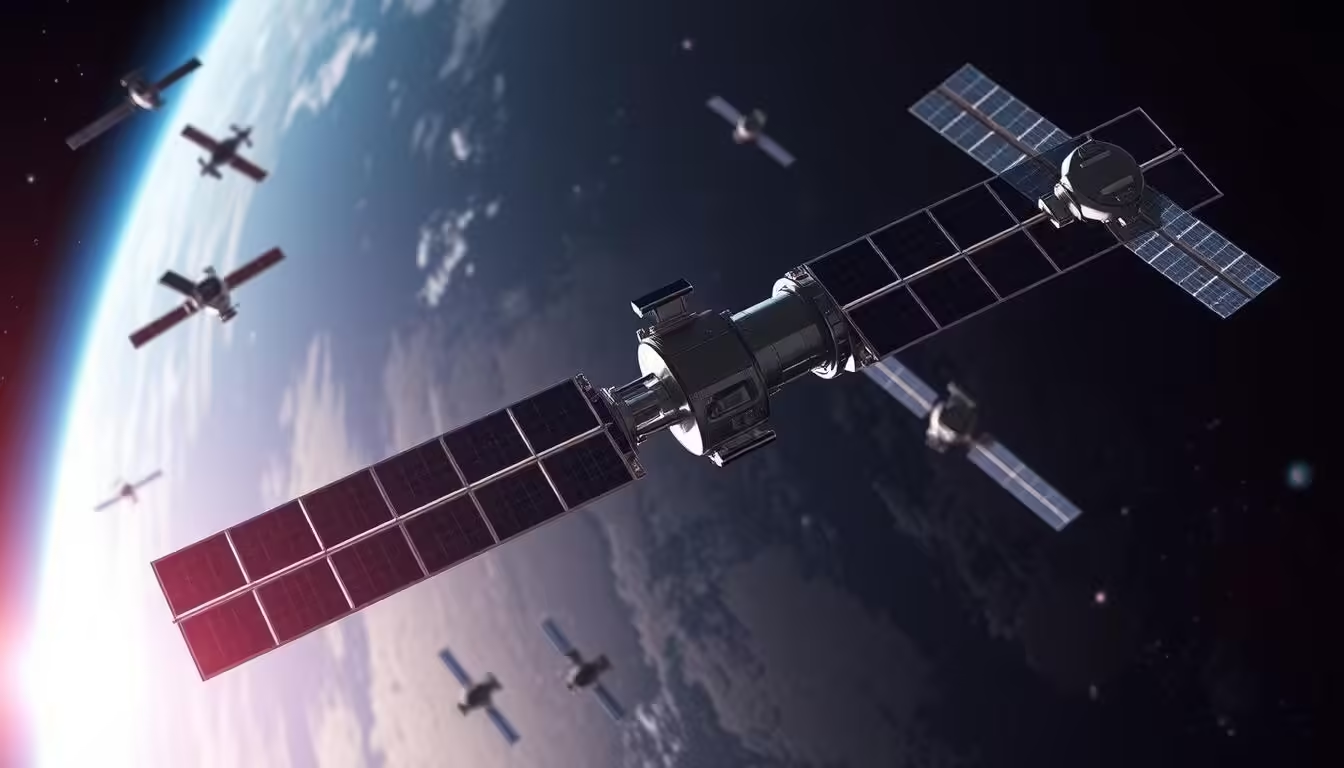Precision agriculture is revolutionizing the way we grow food. By leveraging advanced technologies like satellites and drones, farmers can now produce more with less. This innovative approach enables them to optimize crop yields while reducing water and chemical usage.
The use of satellites and drones in precision agriculture allows for real-time monitoring and data collection. This data is then used to make informed decisions, ensuring that crops receive exactly what they need to thrive. As a result, precision agriculture is not only boosting food production but also promoting sustainability.
Key Takeaways
- Precision agriculture boosts food production while reducing water and chemical usage.
- Satellites and drones play a crucial role in precision agriculture, enabling real-time monitoring.
- This approach promotes sustainability by optimizing resource allocation.
- Precision agriculture is revolutionizing the farming industry.
- Advanced technologies are being leveraged to improve crop yields.
The Revolution of Precision Agriculture in Modern Farming
Precision agriculture is transforming the agricultural landscape through data-driven insights. This modern farming approach leverages advanced technology to optimize crop yields, reduce waste, and promote sustainability.

Defining Precision Agriculture and Its Core Principles
Precision agriculture involves the use of advanced technology and data analysis to improve farming efficiency. According to the Food and Agriculture Organization, “precision agriculture is a farming management concept that combines technology, data analysis, and agronomic expertise to optimize crop yields and reduce environmental impact.”
The core principles of precision agriculture include the use of satellite and drone technology, GPS guidance, and data analytics to make informed decisions. This approach enables farmers to monitor and manage their crops more effectively, reducing the need for excessive water and chemicals.
The Shift from Traditional to Data-Driven Farming
The shift from traditional farming methods to data-driven approaches has been significant. As noted by industry experts, “data-driven farming allows for more precise application of resources, resulting in higher yields and lower environmental impact.”
Data-driven farming involves the collection and analysis of data on soil moisture, crop health, and weather patterns. This information is used to optimize irrigation, fertilization, and pest control, leading to more efficient and sustainable farming practices.
The Evolution of Agricultural Technology: From Manual Labor to Digital Fields
From ancient irrigation systems to modern drones, agricultural innovation has continually evolved to meet the world’s growing food demands. This evolution is a testament to human ingenuity and the relentless pursuit of efficiency and sustainability in farming practices.
Historical Context of Farming Innovation
The history of agricultural technology is as old as civilization itself. Early innovations, such as the plow and irrigation systems, marked significant milestones in the development of farming.
As societies grew, so did the need for more efficient farming techniques, leading to the development of new tools and methods. The introduction of the steel plow in the 19th century, for example, revolutionized farming by allowing for deeper and more efficient tilling of the soil.
Key Technological Milestones Leading to Precision Agriculture
The journey towards precision agriculture has been paved with numerous technological advancements. The advent of GPS technology, for instance, enabled farmers to precision-guide their equipment, reducing waste and improving crop yields.
More recently, the integration of drones and satellite imaging has allowed for real-time monitoring of crop health and soil conditions. As
“The future of farming is not just about growing crops; it’s about growing data.”
, said by a leading agricultural technologist, encapsulates the essence of modern agricultural innovation.
The combination of these technologies has set the stage for the next generation of farming practices, where data-driven decision-making is becoming the norm.
Eyes in the Sky: How Satellite Technology Transforms Farming
Satellite technology has revolutionized the agricultural sector by providing farmers with critical data to enhance crop yields and reduce waste. This technological advancement is a cornerstone of precision agriculture, enabling farmers to make informed decisions based on real-time data.
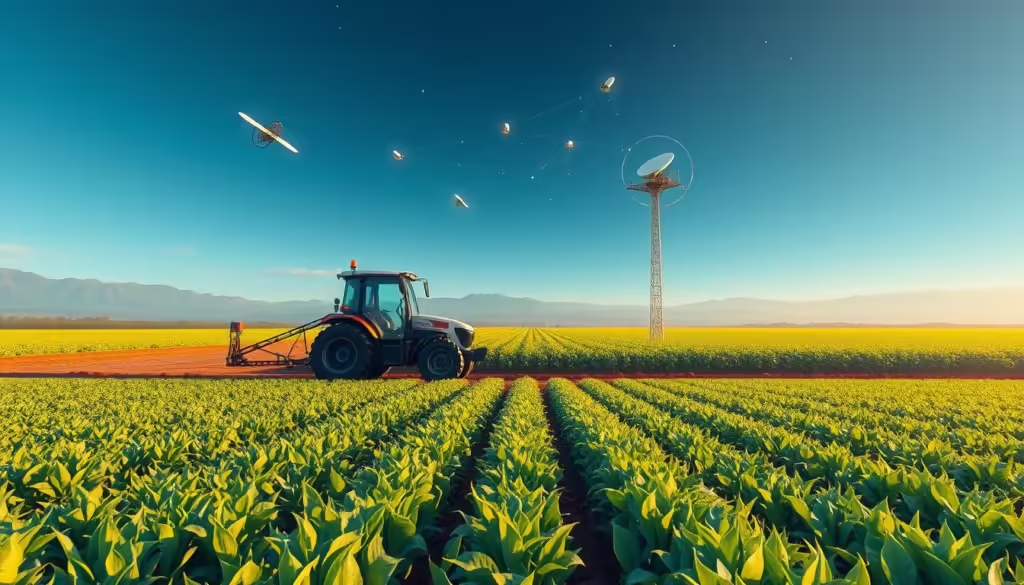
Types of Satellite Data Used in Agriculture
Satellites provide a variety of data that are crucial for agricultural applications. This includes:
- Multispectral and hyperspectral imagery for crop health assessment
- Thermal imaging for soil moisture monitoring
- Synthetic Aperture Radar (SAR) for land deformation and crop monitoring
Remote Sensing and Field Mapping Capabilities
Remote sensing technology allows for the detailed mapping of fields, providing insights into soil types, crop growth, and moisture levels. This information is vital for:
- Identifying areas that require irrigation or drainage
- Monitoring crop health and detecting issues early
- Optimizing fertilizer and pesticide application
Real-time Monitoring and Decision Support Systems
Satellite technology enables real-time monitoring of agricultural fields, allowing farmers to respond quickly to changes in crop conditions. Decision support systems (DSS) use this data to provide recommendations on farming practices, helping to improve yields and reduce environmental impact.
By leveraging satellite technology, farmers can adopt more sustainable practices, contributing to climate change mitigation and environmental conservation. The integration of satellite data into farming operations is a significant step towards a more efficient and sustainable agricultural sector.
The Rise of Agricultural Drones: Capabilities and Applications
The integration of drones in agriculture marks a significant shift towards precision farming. Agricultural drones are equipped with advanced technology that enables farmers to monitor and manage their crops more effectively.
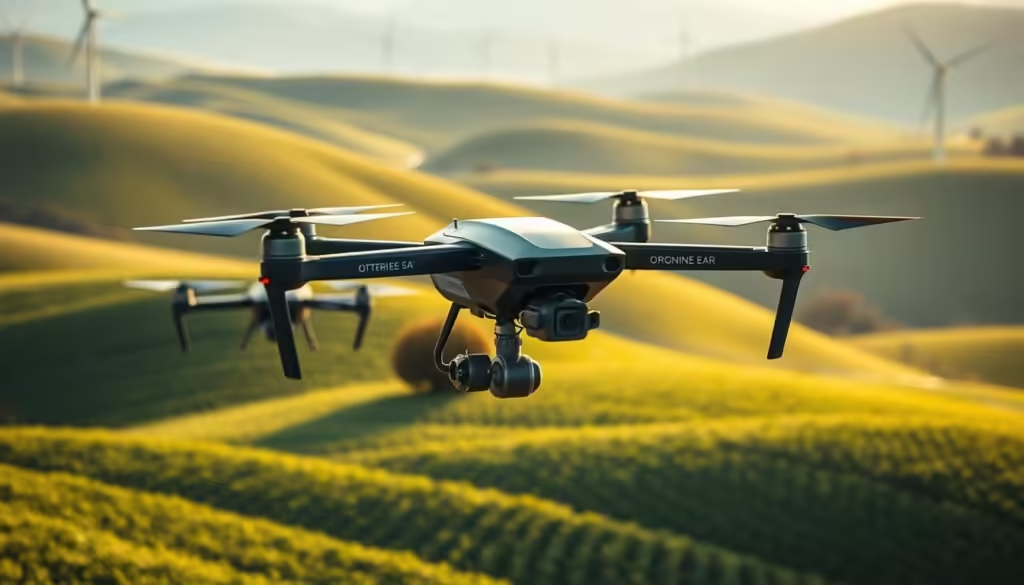
Types of Drones Used in Precision Farming
Precision farming utilizes various types of drones, each designed to serve specific purposes. The choice between fixed-wing and multirotor drones depends on the farm’s needs.
Fixed-Wing vs. Multirotor Drones for Different Farm Needs
Fixed-wing drones are ideal for covering large areas and are often used for aerial imaging. Multirotor drones, on the other hand, offer more flexibility and are used for tasks that require more maneuverability.
Specialized Sensors and Equipment
Drones can be equipped with specialized sensors and equipment, such as multispectral or hyperspectral cameras, to capture detailed data on crop health and growth.
Aerial Imaging and Crop Assessment Functions
Aerial imaging is a key function of agricultural drones, allowing farmers to assess crop health, detect issues early, and make informed decisions. This technology enables the creation of detailed maps and surveys of the land.
Targeted Application of Resources via Drone Technology
Drones enable the targeted application of resources such as fertilizers and pesticides, reducing waste and minimizing environmental impact. This precision application is a significant step towards more sustainable farming practices.
By leveraging drone technology, farmers can not only improve crop yields but also contribute to a more environmentally friendly agricultural practice.
Boosting Crop Yields: Data-Driven Approaches to Food Production
Data-driven farming is revolutionizing the way we produce food, making it possible to boost crop yields while minimizing environmental impact. By leveraging advanced technologies and data analysis, farmers can now make informed decisions to optimize crop production.
Precision Seeding and Planting Techniques
Precision seeding involves using data and technology to optimize the planting process. This includes:
- Soil analysis to determine the best seed varieties
- Precision planting equipment to ensure accurate seed placement
- Data-driven decisions on planting density and timing
These techniques help in achieving uniform crop emergence and maximizing yields.

Crop Health Monitoring and Yield Prediction
Crop health monitoring is crucial for early detection of issues that could impact yield. This involves:
Early Disease Detection Systems
Advanced sensors and drones equipped with multispectral or hyperspectral cameras can detect early signs of disease or stress in crops, allowing for timely intervention.
Harvest Timing Optimization
Data analytics and predictive models help farmers determine the optimal time for harvesting, ensuring that crops are picked at the peak of maturity, thus maximizing yield and quality.
By adopting these data-driven approaches, farmers can significantly improve crop yields while promoting sustainable agricultural practices.
Water Conservation Through Precision Irrigation Systems
Smart irrigation technologies are transforming the way farmers manage water resources, enabling them to conserve water while maintaining crop health. Precision irrigation systems utilize advanced technologies to optimize water application, reducing waste and ensuring that crops receive the right amount of moisture.

Smart Water Management Technologies
Smart water management involves the use of sensors, IoT devices, and data analytics to monitor soil moisture levels, weather conditions, and crop water requirements. This information is used to create optimized irrigation schedules, ensuring that water is applied efficiently.
- Soil moisture sensors provide real-time data on soil conditions.
- Weather stations offer forecasts and current weather conditions.
- Data analytics platforms process information to create personalized irrigation plans.
Soil Moisture Monitoring and Targeted Irrigation
Soil moisture monitoring is crucial for targeted irrigation. By understanding the moisture levels in the soil, farmers can avoid over-irrigation, which wastes water and can lead to root rot and other problems.
Drip Irrigation and Micro-Sprinkler Systems
Drip irrigation and micro-sprinkler systems deliver water directly to the roots of plants, minimizing evaporation and runoff. These systems are highly efficient and can be controlled precisely using smart irrigation controllers.
Weather-Based Irrigation Scheduling
Weather-based irrigation scheduling adjusts irrigation plans according to weather forecasts, ensuring that farmers don’t irrigate during rainy periods or when high winds might cause excessive evaporation.
By adopting precision irrigation systems, farmers can significantly contribute to water conservation efforts while maintaining healthy crops and improving their bottom line through reduced water waste.
Reducing Chemical Usage with Targeted Application Methods
The agricultural sector is witnessing a significant shift towards reducing chemical usage through targeted application methods. This approach not only helps in minimizing the environmental footprint of farming but also contributes to more efficient use of resources.
Precision Spraying Technologies
Precision spraying technologies have emerged as a crucial tool in modern agriculture. These technologies enable farmers to apply chemicals precisely where they are needed, reducing waste and minimizing the impact on the environment. Precision spraying involves the use of GPS-guided systems and sensors to ensure accurate application.
| Technology | Description | Benefits |
|---|---|---|
| GPS-Guided Sprayers | Use GPS for precise navigation and application | Reduced overlap, increased accuracy |
| Sensor-Based Systems | Detect weeds, diseases, and pests for targeted treatment | Minimized chemical usage, cost savings |
Integrated Pest Management Using Technology
Integrated Pest Management (IPM) is a holistic approach that combines different strategies to manage pests effectively. Technology plays a vital role in IPM by providing tools for monitoring, predicting, and controlling pest populations.
Spot Treatment vs. Broadcast Application
Spot treatment involves applying chemicals directly to the affected areas, whereas broadcast application spreads chemicals over the entire field. Spot treatment is more efficient and environmentally friendly.
Reducing Environmental Contamination
By adopting targeted application methods, farmers can significantly reduce environmental contamination. This approach helps in protecting water bodies, soil health, and biodiversity.
“The use of precision agriculture technologies, including precision spraying, is a game-changer for reducing chemical usage in farming.”
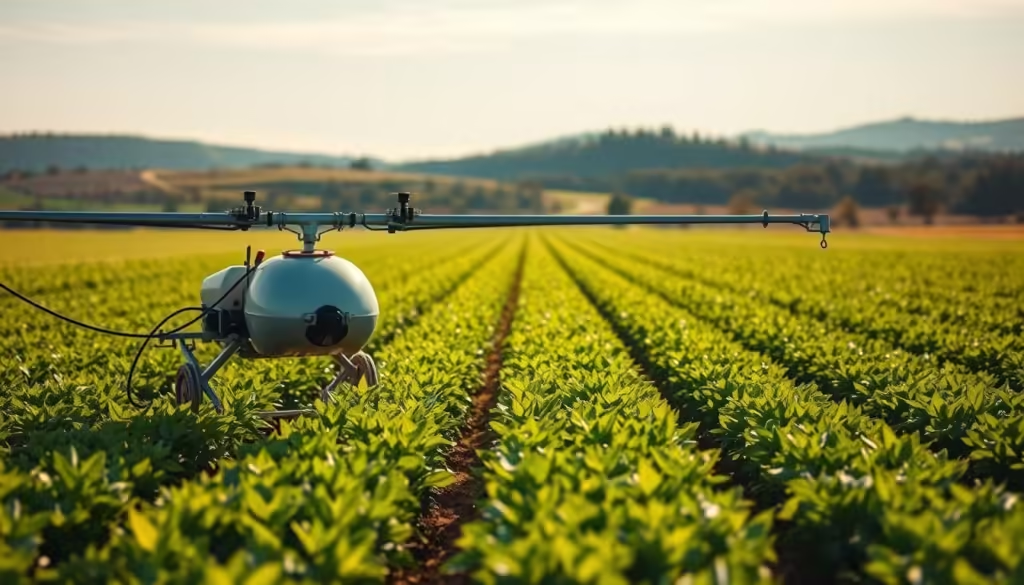
The integration of precision spraying technologies and IPM strategies is revolutionizing the way farming is done. By minimizing chemical usage, farmers can not only reduce their environmental impact but also improve crop yields and quality.
Earth Technology and Sustainability: How Precision Agriculture Supports Green Tech Goals
As the world grapples with climate change, precision agriculture emerges as a critical tool for sustainability. By leveraging advanced technologies like satellites and drones, farmers can now adopt practices that not only boost crop yields but also reduce their environmental footprint.
Reducing Agriculture's Environmental Footprint
Precision agriculture enables farmers to use resources more efficiently, reducing waste and minimizing the use of chemicals and water. Targeted application of fertilizers and pesticides means less runoff into waterways, protecting local ecosystems.
“The use of precision agriculture has allowed us to cut down on unnecessary chemical applications, which not only saves us money but also helps in preserving the environment,” says a farmer who has adopted these practices.
Contribution to Climate Change Mitigation
Precision agriculture plays a significant role in climate change mitigation through various practices. Two key areas of focus are carbon sequestration and reducing greenhouse gas emissions.
Carbon Sequestration Potential
By optimizing soil health through precision farming techniques, soils can become significant carbon sinks. Practices like no-till or reduced-till farming, cover cropping, and organic amendments enhance soil’s carbon sequestration potential.
Reducing Greenhouse Gas Emissions from Farming
Precision agriculture helps in reducing emissions by optimizing the use of machinery and fertilizers. For instance, precision application of nitrogen fertilizers reduces nitrous oxide emissions, a potent greenhouse gas.
As we move forward, the integration of precision agriculture with other sustainable practices will be crucial in our fight against climate change, supporting broader green tech goals.
Real-World Success Stories: Farmers Embracing Precision Agriculture
The adoption of precision agriculture has led to remarkable success stories among farmers, showcasing the potential of technology in farming. Farmers are now able to make data-driven decisions, optimizing their crop yields and reducing waste.
Large-Scale Commercial Farm Implementations
Large commercial farms have been at the forefront of adopting precision agriculture technologies. These farms have seen significant improvements in efficiency and productivity. For instance, the use of satellite imaging and GPS-guided equipment has enabled farmers to monitor and manage their crops more effectively.
Small and Medium Farm Adaptations
Small and medium-sized farms are also benefiting from precision agriculture. These farms often face challenges in terms of resource constraints, but they are finding innovative ways to adapt precision agriculture technologies to their needs.
Cost-Effective Solutions for Smaller Operations
Smaller farms are leveraging cost-effective solutions such as drone technology and mobile apps to monitor crop health and manage resources. These technologies are providing them with the data they need to make informed decisions without breaking the bank.
Cooperative Models for Technology Access
Some small and medium-sized farms are forming cooperatives to share resources and access precision agriculture technologies. This collaborative approach is helping them overcome the barriers to adoption and benefit from economies of scale.
| Farm Size | Precision Agriculture Technologies | Benefits |
|---|---|---|
| Large-Scale | Satellite Imaging, GPS-Guided Equipment | Increased Efficiency, Productivity |
| Small and Medium | Drone Technology, Mobile Apps | Cost-Effective, Data-Driven Decisions |
Challenges and Limitations in Implementing Precision Agriculture
Despite its potential, precision agriculture faces several challenges that hinder its widespread adoption. The integration of advanced technologies such as satellites and drones into farming practices requires significant investment in infrastructure and technical expertise.
Technical Barriers and Infrastructure Requirements
One of the primary challenges is the lack of adequate infrastructure in rural areas, including reliable internet connectivity and sufficient data storage facilities. Additionally, the cost of acquiring and maintaining precision agriculture technology can be prohibitively expensive for many farmers.
| Technical Barrier | Description | Impact |
|---|---|---|
| Limited Internet Connectivity | Insufficient internet access in rural areas | Hinders data transfer and real-time monitoring |
| High Cost of Technology | Expensive equipment and maintenance costs | Unaffordable for small and medium-sized farms |
Accessibility Issues for Small and Medium-sized Farms
Small and medium-sized farms often face significant barriers to adopting precision agriculture due to limited financial resources and lack of technical knowledge. This can lead to a digital divide, where larger farms reap the benefits of precision agriculture while smaller farms are left behind.
Addressing these challenges will be crucial to ensuring that the benefits of precision agriculture are accessible to all farmers, regardless of their farm size or resources.
Conclusion: The Future of Farming in a Technology-Driven World
The future of farming is being reshaped by technology, with precision agriculture at the forefront of this revolution. By harnessing the power of satellites, drones, and data-driven approaches, the agricultural sector is becoming more productive, sustainable, and environmentally friendly.
As we move forward, the integration of technology in farming will continue to play a vital role in achieving Sustainability and Green Tech goals. With the global population projected to reach 9.7 billion by 2050, the need for efficient and sustainable food production methods has never been more pressing.
Technology-Driven Agriculture is not only enhancing crop yields but also reducing the environmental footprint of farming. By adopting precision agriculture practices, farmers can minimize waste, conserve water, and reduce the use of chemicals, contributing to a more sustainable food system.
The Future of Farming looks promising, with ongoing innovations and advancements in precision agriculture. As the industry continues to evolve, it is essential for farmers, policymakers, and stakeholders to work together to ensure that the benefits of technology are accessible to all, promoting a more sustainable and food-secure future.
FAQ
What is precision agriculture?
Precision agriculture is a farming practice that uses advanced technology, such as satellites and drones, to optimize crop yields and reduce waste.
How do satellites contribute to precision agriculture?
Satellites provide critical data on soil moisture, crop health, and weather patterns, enabling farmers to make informed decisions about planting, irrigation, and harvesting.
What types of drones are used in precision farming?
Both fixed-wing and multirotor drones are used in precision farming, each with its own strengths and applications, such as aerial imaging and crop assessment.
How does precision irrigation conserve water?
Precision irrigation systems use soil moisture monitoring and weather data to optimize water application, reducing waste and conserving this valuable resource.
Can precision agriculture help reduce chemical usage?
Yes, precision agriculture enables targeted application of chemicals, such as fertilizers and pesticides, reducing the overall amount used and minimizing environmental impact.
What are the benefits of precision seeding and planting?
Precision seeding and planting techniques optimize crop spacing, depth, and timing, leading to improved yields and reduced waste.
How does precision agriculture support sustainability?
By reducing waste, conserving water, and minimizing chemical usage, precision agriculture contributes to a more sustainable food production system.
What are the challenges in implementing precision agriculture?
Technical barriers, infrastructure requirements, and accessibility issues for small and medium-sized farms are some of the challenges faced in implementing precision agriculture.
Are there cost-effective solutions for smaller farms?
Yes, cooperative models and cost-effective technologies are emerging to make precision agriculture more accessible to smaller farms.
How can farmers access precision agriculture technology?
Farmers can access precision agriculture technology through various means, including equipment suppliers, agricultural service providers, and cooperative models.


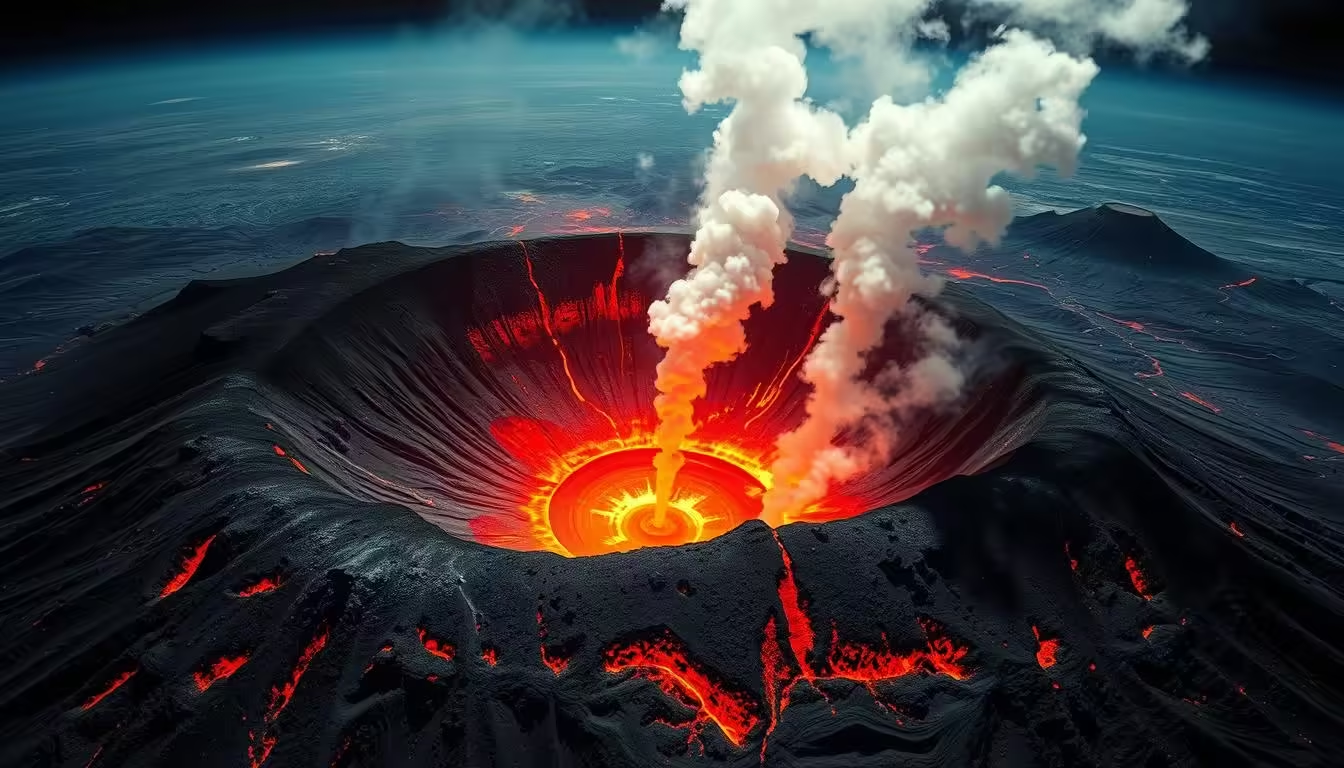









 These solutions often fail to meet the needs of rural communities, highlighting the need for innovative approaches like Low Earth Orbit (LEO) satellites.
These solutions often fail to meet the needs of rural communities, highlighting the need for innovative approaches like Low Earth Orbit (LEO) satellites.




